skip to main |
skip to sidebar
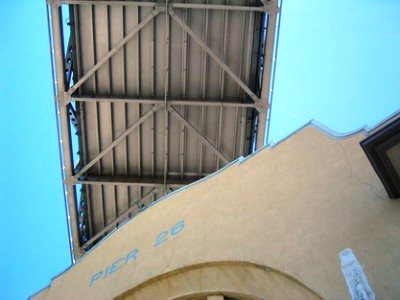
(Sittin' on) The Dock of the Bay was written by Otis Redding and guitarist Steve Cropper. Otis wrote the first verse on a houseboat in Sausalito, CA after playing the Monterey Pop Festival. The song was recorded December 7, 1967, three days before Otis died in a plane crash near Madison, Wisconsin at the age of 26. Cropper, devastated, began mixing the song even as divers searched a lake for Redding's body. A final verse had yet to be written, and Cropper retained Otis's scratch-whistling at the end of the tune. Upon release in January 1968, the record spent 12 weeks on the charts, four of those at the top position, Billboard's first posthumous #1. It's 2:38 of bittersweet moanin' and pleadin' brilliance by the man from Dawson, GA. You can listen here.
(Sittin' on) The Dock of the Bay: Sittin' in the mornin' sun; I'll be sittin' when the evenin' come; Watching the ships roll in; And then I watch 'em roll away again, yeah; I'm sittin' on the dock of the bay; Watching the tide roll away; Ooo, I'm just sittin' on the dock of the bay;  Wastin' time; I left my home in Georgia; Headed for the 'Frisco bay; 'Cause I've had nothing to live for; And look like nothin's gonna come my way; So I'm just gonna sit on the dock of the bay; Watching the tide roll away; Ooo, I'm sittin' on the dock of the bay; Wastin' time; Look like nothing's gonna change; Everything still remains the same; I can't do what ten people tell me to do; So I guess I'll remain the same, yes; Sittin' here resting my bones; And this loneliness won't leave me alone; It's two thousand miles I roamed; Just to make this dock my home; Now, I'm just gonna sit at the dock of the bay; Watching the tide roll away; Oooo-wee, sittin' on the dock of the bay; Wastin' time (whistle).
Wastin' time; I left my home in Georgia; Headed for the 'Frisco bay; 'Cause I've had nothing to live for; And look like nothin's gonna come my way; So I'm just gonna sit on the dock of the bay; Watching the tide roll away; Ooo, I'm sittin' on the dock of the bay; Wastin' time; Look like nothing's gonna change; Everything still remains the same; I can't do what ten people tell me to do; So I guess I'll remain the same, yes; Sittin' here resting my bones; And this loneliness won't leave me alone; It's two thousand miles I roamed; Just to make this dock my home; Now, I'm just gonna sit at the dock of the bay; Watching the tide roll away; Oooo-wee, sittin' on the dock of the bay; Wastin' time (whistle).
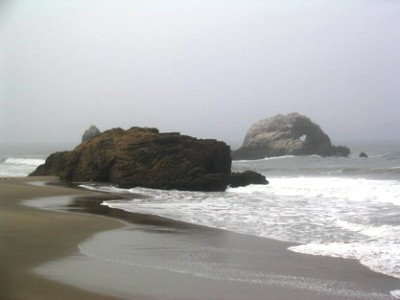

This is a conclusion. It's also a test. Today's post is the VERY LAST from the Central Savannah River Area, USA. It also marks the beginning of a format change. In the future, each post will include three photos that are somehow related and, although I will write something or other, text will be kept to a minimum. Don't worry, I haven't got a notebook full of poems I've been waiting to spring on you. I promise the text will be relevant, at least as relevant as it ever is. Also, in the last couple days, I've received comments fleshing out the details regarding the fire at the Hampton Terrace Hotel and verifying that the window the Galt sisters scratched their names into with Emily's engagement ring (before Emily's fiancee was killed in the Civil War and she leaped to her death) still exists. This is in addition to fact-filled comments on the brick factory, brick manufacturing, and the haunted honky-tonk (the main character from 3 Faces of Eve actually danced on tables there!). Man, I love this stuff. If you have info related to anything you read here, please leave a note. In fact, if you have a CSRA story that fits with City of Dust's style (sure, just a wee bit dark), then let me know and I'll post it. 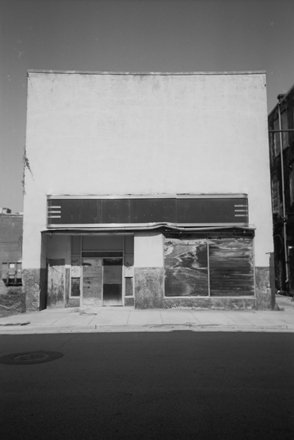 Hell, if you've got a good story from somewhere ELSE lemme know. Yes, YOU can now be a part of CoD. And thanks to everyone that's commented so far. This is also a good time to mention that James Brown, "the most famous person to come out of Augusta," according to Mayor Bob Young, got his statue. Awhile back I did a bit on why the James Brown festival was cancelled last year (domestic assault) and speculated about the status of the life-size bronze statue that went with it (gathering dust in a warehouse). Well, on May 6th, 3 days after the Godfather of Soul turned 72 years old, the statue was unveiled in Augusta Common. What the hell, they already had the thing made! Actually, regardless of his personal problems, I'd say the guy deserves a statue in his hometown. James attended the ceremony, but did not perform, a change from the original event. Rev. Al Sharpton, Brown's former road manager, was also present, and offered a prayer of dedication. At least he was supposed to. Nobody I know actually attended the event! No, I don't consider golf a valid excuse. (You know who you are!) So, if anyone can offer an eyewitness account, please do. A great picture of James at the edge of The Terry during the unveiling of JB Blvd. in 1993 can be found at the Augusta Chronicle. The shot is about 1/3 of the way down the page. The next post will be dedicated to Otis Redding. Check back to find out why. Oh, and the pictures are a last look at the Woolworth's that runs between Broad and Ellis. We've seen it before. Rumor is the building is soon to be renovated. G'night.
Hell, if you've got a good story from somewhere ELSE lemme know. Yes, YOU can now be a part of CoD. And thanks to everyone that's commented so far. This is also a good time to mention that James Brown, "the most famous person to come out of Augusta," according to Mayor Bob Young, got his statue. Awhile back I did a bit on why the James Brown festival was cancelled last year (domestic assault) and speculated about the status of the life-size bronze statue that went with it (gathering dust in a warehouse). Well, on May 6th, 3 days after the Godfather of Soul turned 72 years old, the statue was unveiled in Augusta Common. What the hell, they already had the thing made! Actually, regardless of his personal problems, I'd say the guy deserves a statue in his hometown. James attended the ceremony, but did not perform, a change from the original event. Rev. Al Sharpton, Brown's former road manager, was also present, and offered a prayer of dedication. At least he was supposed to. Nobody I know actually attended the event! No, I don't consider golf a valid excuse. (You know who you are!) So, if anyone can offer an eyewitness account, please do. A great picture of James at the edge of The Terry during the unveiling of JB Blvd. in 1993 can be found at the Augusta Chronicle. The shot is about 1/3 of the way down the page. The next post will be dedicated to Otis Redding. Check back to find out why. Oh, and the pictures are a last look at the Woolworth's that runs between Broad and Ellis. We've seen it before. Rumor is the building is soon to be renovated. G'night.
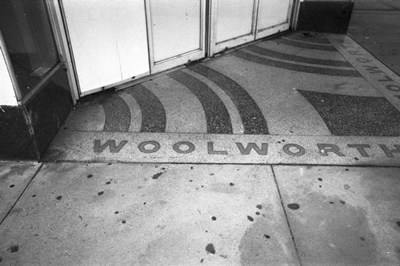
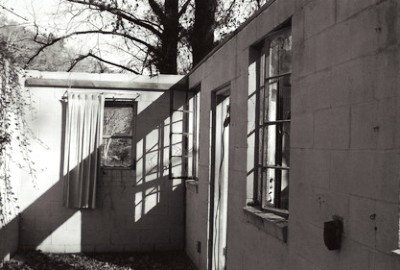
And with a new day comes...a change in film stock! The photos for this post were shot this winter with Kodak TX 400 film that expired in 1996. None of that refrigerator storage either. I've never paid attention to expiration dates anyway. While shooting a roll of toasted film would be very annoying, it wouldn't make me throw up for two days like some other things I can think of. Anyway, this post is all about the North Augusta that was and then, overnight, was not. It's also about the North Augusta that ALMOST was and the one that soon will be. Confused? Anyway, if the stars had aligned just a little bit differently many years ago the entire world might know all about North Augusta, SC. These first few photos mark a last return to the bath house on Buena Vista, by Crystal Lake. We've seen this place before in technicolor.
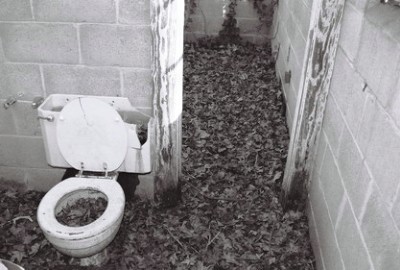
The story starts in the late 1800's with James U. Jackson, whose dream was to build a city on the bluffs across the river from Augusta and get rich doing it. In 1890, with the help of the Mealing family (of Getzen's Pond "fame"), Mr. Jackson began acquiring land. Eventually Jackson found himself with over 5,000 acres (about $100,000 worth), comprising an area that ran along the river's edge and up present-day Georgia Avenue. With some decent acreage under his belt, James U. hired a design firm out of New York and entrusted them with the layout of the new town. He also built a bridge across the river at 13th St., surely making enemies of the folks running the suddenly-obsolete ferry service, but ensuring that people could get in and out of his new town of North Augusta with supreme ease. By 1897, Jackson had bought Augusta's trolley system out from under them (via previous owner W.B. Dyer) and immediately ran a line across the new bridge to N.A. Service was soon extended to Aiken, and the longest inter-urban trolley system in the world was in full operation.
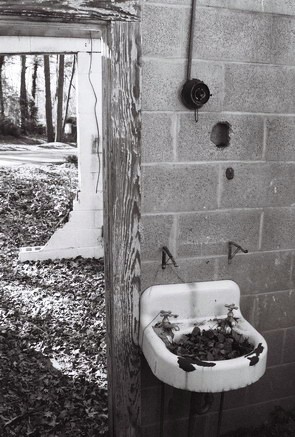 By the turn of the century things were looking pretty good for N.A. and James Jackson figured that all that remained was to build one of the largest luxury hotels in the nation on a hill above the town. And so it was that in April of 1902 construction of the Hampton Terrace Hotel was completed at a cost of $536,000. In those days, half-a-mil got you a five-story castle with 600 rooms and a full-sized eighteen-hole golf course that was literally right outside the front door. The building itself was longer than two football fields and contained enough glass to put windows into 70 standard residential homes. In fact, the Hampton Terrace was so big that people have said it essentially WAS North Augusta and, though the hotel was built in the spring of 1902, it took until December 1903 to get the place furnished and ready for business.
By the turn of the century things were looking pretty good for N.A. and James Jackson figured that all that remained was to build one of the largest luxury hotels in the nation on a hill above the town. And so it was that in April of 1902 construction of the Hampton Terrace Hotel was completed at a cost of $536,000. In those days, half-a-mil got you a five-story castle with 600 rooms and a full-sized eighteen-hole golf course that was literally right outside the front door. The building itself was longer than two football fields and contained enough glass to put windows into 70 standard residential homes. In fact, the Hampton Terrace was so big that people have said it essentially WAS North Augusta and, though the hotel was built in the spring of 1902, it took until December 1903 to get the place furnished and ready for business.
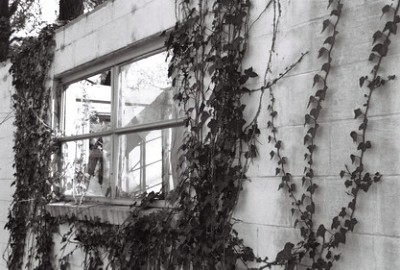
The Hampton Terrace was an immediate success. Wealthy folks who'd been flocking to Aiken to escape spending cold winters in their northern mansions were delighted that such a luxurious pad had gone up just down the road. James U. didn't need a winter retreat himself; he'd just finished his own mansion, Rosemary Hall, up on Carolina Avenue. In North Augusta, the hotel was the most profitable industry bar-none, out-earning both cotton production and the entirety of the town's banking operations. In fact, the hotel was often booked-solid far in advance and other lodges and hotels were built nearby to take up the overflow. One smaller joint was the Sesame Lodge, which didn't mind catering to sub-millionaires, tagging itself as a place where "less formal folk can feel more comfortable."
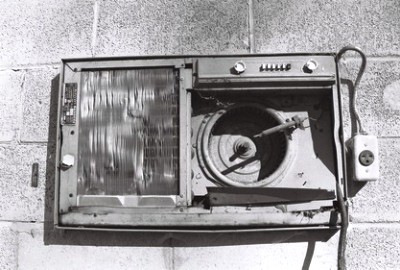
Through the first decade of the century the Hampton Terrace Hotel was really swinging, attracting the richest of the rich and the most famous of the famous. It was around this time that movie moguls, scouting the country for a good location to establish the nascent motion picture industry, wandered into North Augusta. It seemed perfect: the weather was warm, the sun shone a lot, there was this big hotel, and rich people were coming to visit anyway. To that point, the CSRA had not been a hotbed of movie making activity, although at least portions of some early features had been filmed nearby. These included silent movies such as The Littlest Rebel (1914), From the Valley of the Missing (1915), The New Governor (1915), and Charity (1916). (The New Governor, incidentally, was a notorious film. Originally titled The Nigger, the NAACP launched the first media protests in its history against the movie and D.W. Griffith's wildly racist Birth of a Nation, released the same year.) Yet, by the time The Great Moment (1918) and The Arizona Bandit (1920 & filmed entirely in N.A.) were in theaters, North Augusta's shot at becoming Hollywood was long gone. There are really two reasons why Paris Hilton and Ozzy Osbourne don't live in North Augusta. While the first was probably more important, the second was certainly more disastrous.

When the citizens of North Augusta heard that the town was on the verge of becoming Sin City, every man, woman, and child must've imagined their sleepy burg suddenly being transformed into a modern-day Sodom presided over by Satan himself. Um, actually, you know, they may have been right! Anyhow, there was an immediate call to let the moguls know that while their vacation money was one thing, North Augustans would appreciate it if the heaving bosoms and debauched dandies were filmed elsewhere, thank-you-very-much! And so the moguls left: Hello Hollywood, CA! That was effectively the end of that. But worse was to come. Above is yet ANOTHER shot of Hammond's Ferry. Soon to be subdivided.
In the winter of 1916, the Hampton Terrace Hotel closed briefly for improvements and modernizations. It's a good thing this is the last post of CSRA history, 'cause my memory is fading. I used to actually know what the improvements were. I THINK a major part of the process was the installation of electric lights or some-such. Anyway, the re-opening was going to be huge and the hotel was totally booked. 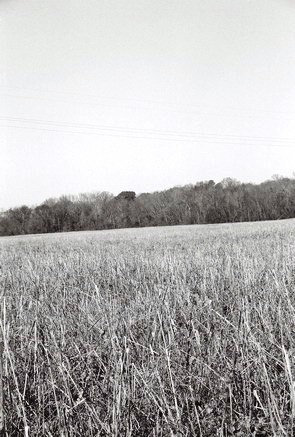 Then, on New Year's Eve, just before the grand unveiling, the hotel burnt to the ground. And I mean, COMPLETELY. There was nothing left. A total loss. However, there actually IS a little left. If you go by the old site, you can still see some of the old brick stairs. Also, I've heard that one of the greens from the golf course can still be identified. Of course, I don't have pictures of these things. You'll have to make do with this doomed field, probably being plowed under as I type. What do you expect? I can't even remember what the CAUSE of the fire was! The new (?) electrical system? A cow tipping over a lantern? Wait, that was Chicago, wasn't it? Anyone? Help?! No, Google had nothing on the subject and there's only one (very rare) book that I've seen with the info.
Then, on New Year's Eve, just before the grand unveiling, the hotel burnt to the ground. And I mean, COMPLETELY. There was nothing left. A total loss. However, there actually IS a little left. If you go by the old site, you can still see some of the old brick stairs. Also, I've heard that one of the greens from the golf course can still be identified. Of course, I don't have pictures of these things. You'll have to make do with this doomed field, probably being plowed under as I type. What do you expect? I can't even remember what the CAUSE of the fire was! The new (?) electrical system? A cow tipping over a lantern? Wait, that was Chicago, wasn't it? Anyone? Help?! No, Google had nothing on the subject and there's only one (very rare) book that I've seen with the info.
Well, everyone expected James U. to immediately get on with the business of rebuilding. But, shockingly, he didn't. Not ever. As a consequence, many people mark New Year's Eve, 1916 as the night that North Augusta's dreams burnt down around her. In recent years, even the Palmetto Lodge (AKA Seven Gables Inn), a grand hunting lodge built for Hampton Terrace guests and a witness to the great fire, had found itself empty and forgotten. But, again, no, I have no pictures. I didn't even make an effort to visit the lodge, despite thinking about it on several occasions. Word was that it was not wise to try to get inside. In my defense, one of the owners was recently convicted of narco-trafficking and boasted of refusing to serve members of the NAACP and James Brown when the place was open! So, you'll just have to pretend this piece of grass, now probably crushed by a dozen bulldozers, represents the forlorn Palmetto Lodge. Or, um, maybe not. Geez, this final CSRA post is making me a little addle-brained, apparently. Anyway, yeah, N. Augusta is now in the throes of big change, including riverfront development (N.A.: "South Carolina's Riverfront") and even a supposed rehabilitation of the Palmetto, possibly by the city itself (if there's an extra $900,000 lying around). Hey, it might not be Hollywood, but at least Sandra Bullock won't steal your parking space. (IMPORTANT NOTE: As of 2008, the Palmetto House is back up and running under new, law-abiding ownership. Go pay a visit if you're hungry or looking for a nice, historic meeting hall!)

Thanks to P. Hughes over at the Henry Shultz/Hamburg site and Ramblin' D. Rhodes for bits of movie info. More on the NAACP's reaction to Birth of a Nation, in particular, has been written by Dr. Susan Zeiger. Also, Augusta Magazine, the North Augusta History Page, and the Aiken Chamber of Commerce helped out. Now, someone please remind me: How DID the hotel burn down?
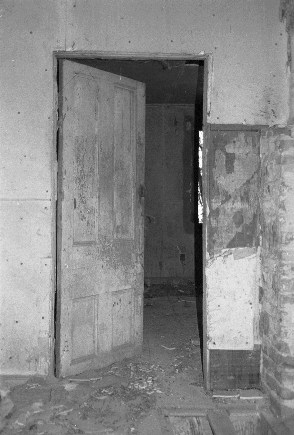 Once again, City of Dust is going on a brief hiatus. I'll be out in the Northwest for the next 11 days, so things will be a little quiet around here. Also, for those of you keeping score, this is the penultimate post from the CSRA to be done in the usual style. In one respect, City of Dust WILL NOT END since I'll still be posting photos and adding commentary of one sort or another. But, in another way, it does feel a bit like the end since I will have completed what I set out to do. And that, of course, was to document the forgotten corners, vacant streets, and abandoned buildings of the Central Savannah River Area, USA via stories and photos. Following the next post, everything is gravy, really, and I make no promises as to what it will be like or how long it will continue. In the meantime, I'm really stretching things out here as that last CSRA post won't be posted 'til late May. For now, we're taking one last walk through the Phinizy Swamp.
Once again, City of Dust is going on a brief hiatus. I'll be out in the Northwest for the next 11 days, so things will be a little quiet around here. Also, for those of you keeping score, this is the penultimate post from the CSRA to be done in the usual style. In one respect, City of Dust WILL NOT END since I'll still be posting photos and adding commentary of one sort or another. But, in another way, it does feel a bit like the end since I will have completed what I set out to do. And that, of course, was to document the forgotten corners, vacant streets, and abandoned buildings of the Central Savannah River Area, USA via stories and photos. Following the next post, everything is gravy, really, and I make no promises as to what it will be like or how long it will continue. In the meantime, I'm really stretching things out here as that last CSRA post won't be posted 'til late May. For now, we're taking one last walk through the Phinizy Swamp.
Since time is tight today, I'm going to relate a few final tales from Sean Joiner's "Haunted Augusta and Local Legends." I swear, if Mr. Joiner ever reads this website he's going to demand compensation. On the other hand, I'm certain the little book he wrote is out-of-print and impossible to find, despite being published in 2002. It's a shame not to get these tales out there, so, Sean, thanks for your understanding! And I do put my own spin on 'em, y'know, adding additional info when I can. This first story is the companion piece to The Belle, Her Soldier, and Their Ghosts, and also takes place on what is now the campus of Augusta State University (ASU). Remember that prior to the Civil War the Augusta Arsenal was moved from near the river to the Hill so that soldiers could escape the rampant malaria? Well, it's said that, very shortly after the Civil War, the commander at the Arsenal hired his nephew on for the princely sum of $2 a day. None of the other soldiers at the Arsenal were making that much money and they were not happy at such an open display of nepotism. As if that wasn't bad enough, one day the nephew left work to get a piece of APPLE PIE! This was too much for poor, malnourished soldiers to bear, and so, as the nephew came down the steps of the Benet Mansion (now the ASU admissions office), belly full of delicious apple pie, he was gunned down by a jealous fellow-soldier. The assassin, it seems, was never caught, probably protected by others that hated this pie-eating nephew. At night, employees and students working late have reported hearing noises coming from the kitchen of the Benet House as the commander's nephew rummages around, desperately looking for one last piece of pie. Below is a shot of a trough in a very dark barn, suitable for the ghosts of horses to visit for one last feed.
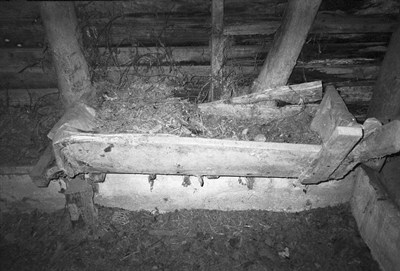
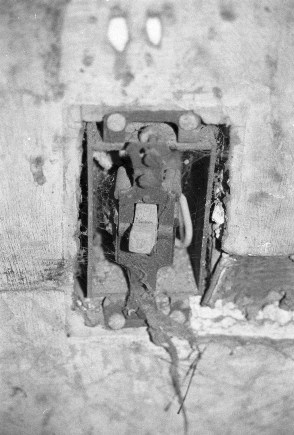 Augusta has long been known as one of the major center's of medical research and training in the country. The Medical Academy of Georgia (AKA Medical College of Georgia) was founded in 1829 by three doctors with the aim of training students in the medical arts. In 1852, the College bought a Gullah slave, Gradison Harris, and prompty taught him reading, writing, and basic anatomy. This was, of course, highly unusual. It should be borne in mind that it was ILLEGAL for slaves to know how to read and write, which is why the lines of poetry written on pottery made in nearby Edgefield, SC by Dave the Slave are so astonishing. Eventually Gradison Harris was told his responsibilities: Each day he would read the obituaries, then, at night, go to Cedar Grove Cemetery to dig up a fresh corpse for use by the medical students in their classes. Isn't it nice that they turned the lights off before vacating this shack?
Augusta has long been known as one of the major center's of medical research and training in the country. The Medical Academy of Georgia (AKA Medical College of Georgia) was founded in 1829 by three doctors with the aim of training students in the medical arts. In 1852, the College bought a Gullah slave, Gradison Harris, and prompty taught him reading, writing, and basic anatomy. This was, of course, highly unusual. It should be borne in mind that it was ILLEGAL for slaves to know how to read and write, which is why the lines of poetry written on pottery made in nearby Edgefield, SC by Dave the Slave are so astonishing. Eventually Gradison Harris was told his responsibilities: Each day he would read the obituaries, then, at night, go to Cedar Grove Cemetery to dig up a fresh corpse for use by the medical students in their classes. Isn't it nice that they turned the lights off before vacating this shack?
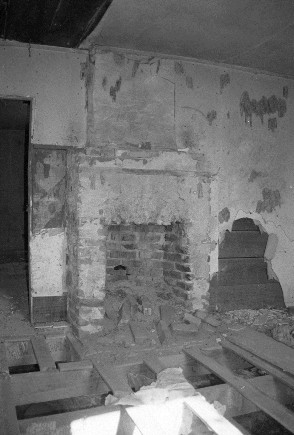 It's said that one evening some medical students saw Gradison Harris at work, then followed him to a local bar where the reluctant graverobber had stopped for a moment to imbibe some liquid fortification. Hey, wouldn't you need a drink? Anyway, Gradison carefully stashed the sack in which that evening's body had been placed before he grabbed a glass of courage. Seeing this, the students decided to play a joke on Gradison and removed the body. Then one of them climbed into the sack. When Harris returned from the bar, the student in the sack moaned that he, too, badly needed a drink. Gradison went running down the street in terror, apparently in no mood to deal with a thirsty corpse.
It's said that one evening some medical students saw Gradison Harris at work, then followed him to a local bar where the reluctant graverobber had stopped for a moment to imbibe some liquid fortification. Hey, wouldn't you need a drink? Anyway, Gradison carefully stashed the sack in which that evening's body had been placed before he grabbed a glass of courage. Seeing this, the students decided to play a joke on Gradison and removed the body. Then one of them climbed into the sack. When Harris returned from the bar, the student in the sack moaned that he, too, badly needed a drink. Gradison went running down the street in terror, apparently in no mood to deal with a thirsty corpse.
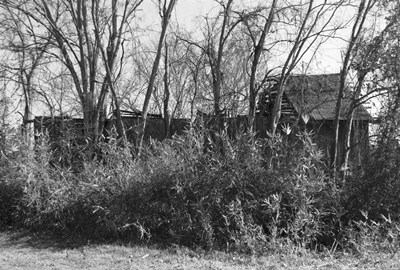
Gradison Harris left the Medical Institute of Georgia, as it was called by then, following abolition. However, he returned later to take a position as a porter. He died in 1911 at the age of 95 and is now buried in, fittingly enough, Cedar Grove Cemetery. During renovation of the College in 1989, the remains of 154 bodies, including vats filled with bones and jars of preserved body parts, were found under the old building. These remains were re-buried in Cedar Grove Cemetery on November 7, 1998. If, in City of Dust's absence over the next couple of weeks, you find yourself bored (as you no doubt will!) I recommend checking out PostSecret, where people send handmade postcards to an anonymous blog, each inscribed with a secret. Some of these secrets are funny, some heartbreaking, some just weird. Nothing like finding comfort in blatant voyeurism. Isn't that the new American way? Seriously, though, PostSecret is pretty amazing and lots of people write in to say they've received some real relief from getting their secrets published. If you don't like to read other people's secrets (what, do you have standards?), then have I mentioned City of Dust's extensive archives?! Yes, I have.
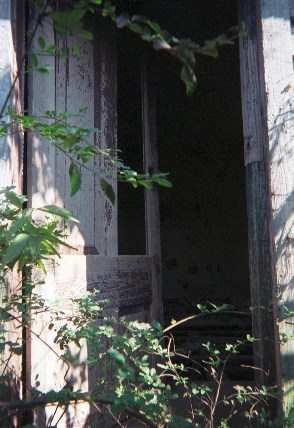 Speaking of secrets, how about one more tale, this from the Sibley Mill, the site of the Confederate Powderworks. On October 20, 1906, workers were just beginning their long day of weaving in the stifling mill. Maude Williams was feeling especially agitated that morning as she'd just broken off an affair she'd been having with a married man, Arthur Glover. Arthur had taken the news very badly and Maude was terribly worried indeed. However, at the Sibley Mill, adultery was no excuse for not reporting for work and so Maude tended carefully to her weaving. Suddenly a shot rang through the building and Maude Williams slumped over, killed by a single bullet. Soon after, Arthur Glover was hanged for murder. In subsequent years, workers reported seeing a woman weaving, intent on her work and oblivious to all around her. Early on, some of these people recognized the woman as Maude and fled in fear. Later, others tried to speak with this new employee but received no answer. Over time, however, sightings diminished, and it now appears that Maude Williams has moved on, her weaving done. See you in a couple weeks.
Speaking of secrets, how about one more tale, this from the Sibley Mill, the site of the Confederate Powderworks. On October 20, 1906, workers were just beginning their long day of weaving in the stifling mill. Maude Williams was feeling especially agitated that morning as she'd just broken off an affair she'd been having with a married man, Arthur Glover. Arthur had taken the news very badly and Maude was terribly worried indeed. However, at the Sibley Mill, adultery was no excuse for not reporting for work and so Maude tended carefully to her weaving. Suddenly a shot rang through the building and Maude Williams slumped over, killed by a single bullet. Soon after, Arthur Glover was hanged for murder. In subsequent years, workers reported seeing a woman weaving, intent on her work and oblivious to all around her. Early on, some of these people recognized the woman as Maude and fled in fear. Later, others tried to speak with this new employee but received no answer. Over time, however, sightings diminished, and it now appears that Maude Williams has moved on, her weaving done. See you in a couple weeks.
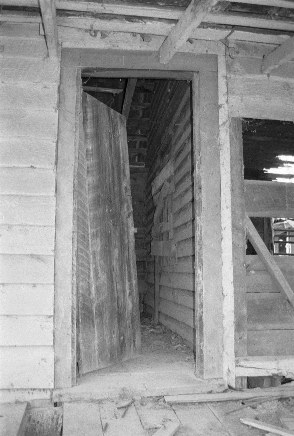 I'm very pleased to report that City of Dust has a feature in the May issue of Photoblogs Magazine, which was just released on-line yesterday. Right off, I'd like to thank Matt, the founder of Photoblogs Magazine, and Charles, the managing editor, for providing such a great forum and giving me the opportunity to take unsuspecting readers on a tour of the City of Dust. I'm really thrilled to be included. Also, I'd like to thank Jeff for doing a bang-up job on the layout and putting up with my nit-picky grammatical revisions. So, go check out the magazine, which you can access by the button on the right there, or just click here. And I'm not asking you to go just 'cause CoD is featured; you should check out the other stories and photos, which are really exceptional. I'm kind of a hack, so I can only hope that I've managed to hold my own to some small degree. Also, there's photo critiques, discussions, and all kinds of other interesting things going on at the magazine, so surf on over right now and come back and read the rest of this post later. You've probably seen the Phinizy Swamp before anyway, and I'll leave the front door open.
I'm very pleased to report that City of Dust has a feature in the May issue of Photoblogs Magazine, which was just released on-line yesterday. Right off, I'd like to thank Matt, the founder of Photoblogs Magazine, and Charles, the managing editor, for providing such a great forum and giving me the opportunity to take unsuspecting readers on a tour of the City of Dust. I'm really thrilled to be included. Also, I'd like to thank Jeff for doing a bang-up job on the layout and putting up with my nit-picky grammatical revisions. So, go check out the magazine, which you can access by the button on the right there, or just click here. And I'm not asking you to go just 'cause CoD is featured; you should check out the other stories and photos, which are really exceptional. I'm kind of a hack, so I can only hope that I've managed to hold my own to some small degree. Also, there's photo critiques, discussions, and all kinds of other interesting things going on at the magazine, so surf on over right now and come back and read the rest of this post later. You've probably seen the Phinizy Swamp before anyway, and I'll leave the front door open.
While I'm thinking about it, I'd also recommend checking out Photoblogs.org which, if I'm not mistaken, provided some of the initial inspiration for Photoblogs Magazine. It's sort of a photoblog clearinghouse, and every photoblog I've ever mentioned on this site can be found through Photoblogs.org, including the Snowsuit Effort, which I recently came across. Previously, I've talked about the difficulties of photographing not just run-down neighborhoods, but also the people that live in them. Taking pictures of homeless men and women is hard to do with sensitivity-minus-exploitation, but Ryan does an excellent job of documenting those who, for a variety of reasons, have found themselves living on the streets of Detroit. Sometimes I'd go into the Phinizy Swamp around midnight and wait for the devil to appear, hoping to make a deal with him. Okay, not really. I like my soul and, besides, despite Charlie Daniel's words to the contrary, it's well known that most of Satan's deal-making takes place on the backroads of Mississippi, not Georgia. Still, the shot below illustrates just how dark it can be in the swamp even at noon. Kill your television!
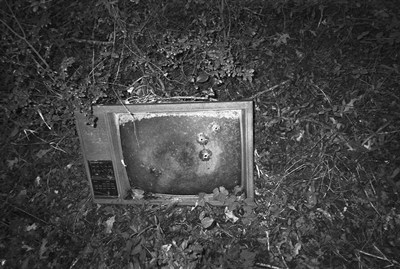
There's a lot of great swamps around Augusta in addition to the Phinizy. There's the Hell Hole Swamp in South Carolina, nestled in the Francis Marion National Forest, near Charleston. It's said that the swamp was named by British soldiers during the Revolutionary War who, after watching General Francis Marion ("The Swamp Fox") and his troops disappear into the darkness, were obliged to go in after him. At some point in the search one redcoat reportedly exclaimed, "That's a hell of a hole!" And Hell Hole it was. They never found Marion and his men. Later, the Hell Hole was the stomping ground of serious bootleggers, who riddled the swamp with stills and rough dirt roads.  Such purveyors of "liquid corn" needed fast cars to make quick getaways, and would race each other to test their newest modifications. A few years later, they sanctioned this activity under the banner NASCAR. It's even rumored that Al Capone went to the Hell Hole Swamp to see how the southern wing of his bootleg empire was getting along. Rival bootleggers went after each other with firearms in the Hell Hole, and liquor from Cuba came up the Santee River for storage in the swamp until it could be moved out to Chicago. SC produce has a high iodine content (license plate mottos boldly read "Iodine" in 1930), and still operators jumped on the health bandwagon. "Not a Goiter in a Gallon" was the slogan of Hell Hole 'shine shipped out of the Iodine State (AKA the Swamp State). Recently, a new high school in the area was almost called Hell Hole High. I'm very disappointed it was not. There's a Hell Hole Swamp Festival each year, where you can enter a tobacco-spitting contest, and test your greased-pole climbing skills. That's in Jamestown, SC, May 7, so make your plans now. Photo caption brought to you by the LA-based rock band X: "We slept for a week, cinders on the sheets." Apparently cinders on the box spring, as well.
Such purveyors of "liquid corn" needed fast cars to make quick getaways, and would race each other to test their newest modifications. A few years later, they sanctioned this activity under the banner NASCAR. It's even rumored that Al Capone went to the Hell Hole Swamp to see how the southern wing of his bootleg empire was getting along. Rival bootleggers went after each other with firearms in the Hell Hole, and liquor from Cuba came up the Santee River for storage in the swamp until it could be moved out to Chicago. SC produce has a high iodine content (license plate mottos boldly read "Iodine" in 1930), and still operators jumped on the health bandwagon. "Not a Goiter in a Gallon" was the slogan of Hell Hole 'shine shipped out of the Iodine State (AKA the Swamp State). Recently, a new high school in the area was almost called Hell Hole High. I'm very disappointed it was not. There's a Hell Hole Swamp Festival each year, where you can enter a tobacco-spitting contest, and test your greased-pole climbing skills. That's in Jamestown, SC, May 7, so make your plans now. Photo caption brought to you by the LA-based rock band X: "We slept for a week, cinders on the sheets." Apparently cinders on the box spring, as well.
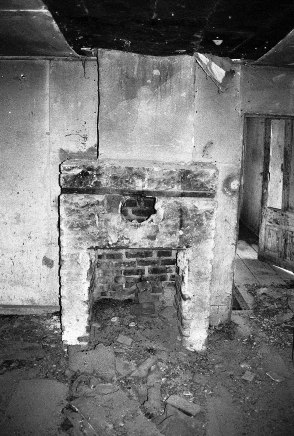 Of course, there's the Okefenokee Swamp, down in southern Georgia, on the Florida border. A 680-sq.-mi. national wildlife refuge, much of the "land" is actually floating peat mat. The Seminole Indians referred to this mat as "ecunnau finocau." That didn't make much sense to settlers in the area, who just called it "Okefenokee." Out of the swamp flows the St. Mary's River, considered to be one of the most crooked, meandering rivers in the world, winding its way east along the GA/FL border to the Atlantic Ocean. The distance as-the-crow-flies is 65 mi., but the river, being in no hurry, does it in a leisurely 175. Another river flows to the Gulf of Mexico from the swamp. You may have heard of it: "Way down upon the Suwanee River." Only, it was misspelled in the song and needs another "n". Anyway, the Okefenokee Swamp is pretty cool, with dark, black water that looks like tea (but doesn't taste like it), and more gators than you can shake a canoe paddle at. That's about 10,000 gators, and still many fewer than there were, say, 250 years ago. You'd think I'd have some photos but, of course, I don't. Instead, here's hearth and home, Phinizy Swamp style.
Of course, there's the Okefenokee Swamp, down in southern Georgia, on the Florida border. A 680-sq.-mi. national wildlife refuge, much of the "land" is actually floating peat mat. The Seminole Indians referred to this mat as "ecunnau finocau." That didn't make much sense to settlers in the area, who just called it "Okefenokee." Out of the swamp flows the St. Mary's River, considered to be one of the most crooked, meandering rivers in the world, winding its way east along the GA/FL border to the Atlantic Ocean. The distance as-the-crow-flies is 65 mi., but the river, being in no hurry, does it in a leisurely 175. Another river flows to the Gulf of Mexico from the swamp. You may have heard of it: "Way down upon the Suwanee River." Only, it was misspelled in the song and needs another "n". Anyway, the Okefenokee Swamp is pretty cool, with dark, black water that looks like tea (but doesn't taste like it), and more gators than you can shake a canoe paddle at. That's about 10,000 gators, and still many fewer than there were, say, 250 years ago. You'd think I'd have some photos but, of course, I don't. Instead, here's hearth and home, Phinizy Swamp style.
Near Harleyville, SC, between Columbia and Charleston, there's the Four Hole Swamp. I don't know much about Four Hole Swamp, but the ol' Swamp Fox, General Francis Marion, hid out there for awhile, using the position to make quick raids on British troops. He wasn't called The Swamp Fox for nuthin'. Four Hole is located within the Francis Biedler National Forest, and near the Congaree National Park, another great swamp. (It used to be Congaree Swamp National Monument, but only a crazy person would go to a swamp for vacation, so they changed the name and the tourists have come running.) The Congaree NP contains some of the largest trees on the east coast, including the SC record bald cypress. That's Taxodium distichum, the tree with the large buttress at the base. I spent a HUGE amount of time in the Congaree measuring trees and, as a reward one hot and miserable day, actually went looking for this record tree, which is in an area that's not easy to access. We eventually found the mammoth cypress, near some nearly-as-mammoth neighbors. Probably the better part of 1,000 years-old, they were really something to see. The biggest bald cypress in the Southeast, I believe, is a 1,400 year-old bruiser in North Carolina. I'd love to say I had a photo of these trees, but, again, no. I didn't bring a camera with me to the Congaree Swamp. I had enough to carry already and, besides, have you ever tried to photograph a 131' tall tree with a 26' circumference? So, you'll have to content yourself with another picture of this shack. Although this was a very inspirational shack. It was one of the first places I shot in Augusta because I REALLY wanted to get a record of its existence.
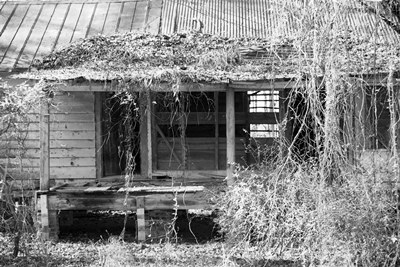
When they first started to cut down cypress trees, they quickly discovered that the trees sank, making them kinda tough to move through water. So, the trees had to be killed with a girdle, then left standing for at least 6 months so they'd dry out and float. By the early 1900's, most large cypress trees in the Southeast were gone. The Swamp Fox himself had said, "I look at the venerable trees around me and know that I must not dishonor them." But I think by "dishonor" he meant not shooting more redcoats. Of course, there are downsides to slogging through swamps. 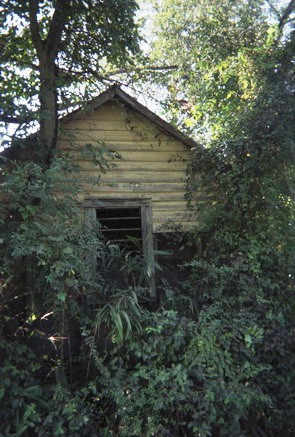 In the Congaree, particularly when walking through stands of cane, you're liable to get a bad case of chiggers. Having received a bad case of chiggers (60+ bites) from just such an activity, I can say it pretty much flat-out sucks. Unless you don't like being able to sleep. On the other hand, there is a certain sensation, which a field technician of mine called "exquisite," that occurs when you wait and wait and wait and then FINALLY give in to a vigorous itch. Or two. Or fifty. There's some cane grass growing in this photo, right under the window. Probably rife with chiggers, too. But, overall, I've spent a couple thousand hours of my life in swamps and am none the worse for it. At least, I don't think I am. If you don't know what a cypress tree looks like, there's a few here. About as far from state records as you can get. I'd also like to mention the Great Dismal Swamp in VA/NC because it has a lovely name, but the swamp itself is out of my jurisdiction. Thanks to Mike Sigalas for writing the South Carolina Moon Handbook and unwittingly helping me out today. Happy May Day! Oh, and did I mention you should check out Photoblogs Magazine?!
In the Congaree, particularly when walking through stands of cane, you're liable to get a bad case of chiggers. Having received a bad case of chiggers (60+ bites) from just such an activity, I can say it pretty much flat-out sucks. Unless you don't like being able to sleep. On the other hand, there is a certain sensation, which a field technician of mine called "exquisite," that occurs when you wait and wait and wait and then FINALLY give in to a vigorous itch. Or two. Or fifty. There's some cane grass growing in this photo, right under the window. Probably rife with chiggers, too. But, overall, I've spent a couple thousand hours of my life in swamps and am none the worse for it. At least, I don't think I am. If you don't know what a cypress tree looks like, there's a few here. About as far from state records as you can get. I'd also like to mention the Great Dismal Swamp in VA/NC because it has a lovely name, but the swamp itself is out of my jurisdiction. Thanks to Mike Sigalas for writing the South Carolina Moon Handbook and unwittingly helping me out today. Happy May Day! Oh, and did I mention you should check out Photoblogs Magazine?!

 Wastin' time; I left my home in Georgia; Headed for the 'Frisco bay; 'Cause I've had nothing to live for; And look like nothin's gonna come my way; So I'm just gonna sit on the dock of the bay; Watching the tide roll away; Ooo, I'm sittin' on the dock of the bay; Wastin' time; Look like nothing's gonna change; Everything still remains the same; I can't do what ten people tell me to do; So I guess I'll remain the same, yes; Sittin' here resting my bones; And this loneliness won't leave me alone; It's two thousand miles I roamed; Just to make this dock my home; Now, I'm just gonna sit at the dock of the bay; Watching the tide roll away; Oooo-wee, sittin' on the dock of the bay; Wastin' time (whistle).
Wastin' time; I left my home in Georgia; Headed for the 'Frisco bay; 'Cause I've had nothing to live for; And look like nothin's gonna come my way; So I'm just gonna sit on the dock of the bay; Watching the tide roll away; Ooo, I'm sittin' on the dock of the bay; Wastin' time; Look like nothing's gonna change; Everything still remains the same; I can't do what ten people tell me to do; So I guess I'll remain the same, yes; Sittin' here resting my bones; And this loneliness won't leave me alone; It's two thousand miles I roamed; Just to make this dock my home; Now, I'm just gonna sit at the dock of the bay; Watching the tide roll away; Oooo-wee, sittin' on the dock of the bay; Wastin' time (whistle). 
 Hell, if you've got a good story from somewhere ELSE lemme know. Yes, YOU can now be a part of CoD. And thanks to everyone that's commented so far. This is also a good time to mention that James Brown, "the most famous person to come out of Augusta," according to Mayor Bob Young, got his statue. Awhile back I did a bit on why the
Hell, if you've got a good story from somewhere ELSE lemme know. Yes, YOU can now be a part of CoD. And thanks to everyone that's commented so far. This is also a good time to mention that James Brown, "the most famous person to come out of Augusta," according to Mayor Bob Young, got his statue. Awhile back I did a bit on why the 


 By the turn of the century things were looking pretty good for N.A. and James Jackson figured that all that remained was to build one of the largest luxury hotels in the nation on a hill above the town. And so it was that in April of 1902 construction of the Hampton Terrace Hotel was completed at a cost of $536,000. In those days, half-a-mil got you a five-story castle with 600 rooms and a full-sized eighteen-hole golf course that was literally right outside the front door. The building itself was longer than two football fields and contained enough glass to put windows into 70 standard residential homes. In fact, the Hampton Terrace was so big that people have said it essentially WAS North Augusta and, though the hotel was built in the spring of 1902, it took until December 1903 to get the place furnished and ready for business.
By the turn of the century things were looking pretty good for N.A. and James Jackson figured that all that remained was to build one of the largest luxury hotels in the nation on a hill above the town. And so it was that in April of 1902 construction of the Hampton Terrace Hotel was completed at a cost of $536,000. In those days, half-a-mil got you a five-story castle with 600 rooms and a full-sized eighteen-hole golf course that was literally right outside the front door. The building itself was longer than two football fields and contained enough glass to put windows into 70 standard residential homes. In fact, the Hampton Terrace was so big that people have said it essentially WAS North Augusta and, though the hotel was built in the spring of 1902, it took until December 1903 to get the place furnished and ready for business.


 Then, on New Year's Eve, just before the grand unveiling, the hotel burnt to the ground. And I mean, COMPLETELY. There was nothing left. A total loss. However, there actually IS a little left. If you go by the old site, you can still see some of the old brick stairs. Also, I've heard that one of the greens from the golf course can still be identified. Of course, I don't have pictures of these things. You'll have to make do with this doomed field, probably being plowed under as I type. What do you expect? I can't even remember what the CAUSE of the fire was! The new (?) electrical system? A cow tipping over a lantern? Wait, that was Chicago, wasn't it? Anyone? Help?! No, Google had nothing on the subject and there's only one (very rare) book that I've seen with the info.
Then, on New Year's Eve, just before the grand unveiling, the hotel burnt to the ground. And I mean, COMPLETELY. There was nothing left. A total loss. However, there actually IS a little left. If you go by the old site, you can still see some of the old brick stairs. Also, I've heard that one of the greens from the golf course can still be identified. Of course, I don't have pictures of these things. You'll have to make do with this doomed field, probably being plowed under as I type. What do you expect? I can't even remember what the CAUSE of the fire was! The new (?) electrical system? A cow tipping over a lantern? Wait, that was Chicago, wasn't it? Anyone? Help?! No, Google had nothing on the subject and there's only one (very rare) book that I've seen with the info. 
 Once again, City of Dust is going on a brief hiatus. I'll be out in the Northwest for the next 11 days, so things will be a little quiet around here. Also, for those of you keeping score, this is the penultimate post from the CSRA to be done in the usual style. In one respect, City of Dust WILL NOT END since I'll still be posting photos and adding commentary of one sort or another. But, in another way, it does feel a bit like the end since I will have completed what I set out to do. And that, of course, was to document the forgotten corners, vacant streets, and abandoned buildings of the Central Savannah River Area, USA via stories and photos. Following the next post, everything is gravy, really, and I make no promises as to what it will be like or how long it will continue. In the meantime, I'm really stretching things out here as that last CSRA post won't be posted 'til late May. For now, we're taking one last walk through the Phinizy Swamp.
Once again, City of Dust is going on a brief hiatus. I'll be out in the Northwest for the next 11 days, so things will be a little quiet around here. Also, for those of you keeping score, this is the penultimate post from the CSRA to be done in the usual style. In one respect, City of Dust WILL NOT END since I'll still be posting photos and adding commentary of one sort or another. But, in another way, it does feel a bit like the end since I will have completed what I set out to do. And that, of course, was to document the forgotten corners, vacant streets, and abandoned buildings of the Central Savannah River Area, USA via stories and photos. Following the next post, everything is gravy, really, and I make no promises as to what it will be like or how long it will continue. In the meantime, I'm really stretching things out here as that last CSRA post won't be posted 'til late May. For now, we're taking one last walk through the Phinizy Swamp. 
 Augusta has long been known as one of the major center's of medical research and training in the country. The Medical Academy of Georgia (AKA Medical College of Georgia) was founded in 1829 by three doctors with the aim of training students in the medical arts. In 1852, the College bought a Gullah slave, Gradison Harris, and prompty taught him reading, writing, and basic anatomy. This was, of course, highly unusual. It should be borne in mind that it was ILLEGAL for slaves to know how to read and write, which is why the lines of poetry written on pottery made in nearby Edgefield, SC by Dave the Slave are so astonishing. Eventually Gradison Harris was told his responsibilities: Each day he would read the obituaries, then, at night, go to Cedar Grove Cemetery to dig up a fresh corpse for use by the medical students in their classes. Isn't it nice that they turned the lights off before vacating this shack?
Augusta has long been known as one of the major center's of medical research and training in the country. The Medical Academy of Georgia (AKA Medical College of Georgia) was founded in 1829 by three doctors with the aim of training students in the medical arts. In 1852, the College bought a Gullah slave, Gradison Harris, and prompty taught him reading, writing, and basic anatomy. This was, of course, highly unusual. It should be borne in mind that it was ILLEGAL for slaves to know how to read and write, which is why the lines of poetry written on pottery made in nearby Edgefield, SC by Dave the Slave are so astonishing. Eventually Gradison Harris was told his responsibilities: Each day he would read the obituaries, then, at night, go to Cedar Grove Cemetery to dig up a fresh corpse for use by the medical students in their classes. Isn't it nice that they turned the lights off before vacating this shack? It's said that one evening some medical students saw Gradison Harris at work, then followed him to a local bar where the reluctant graverobber had stopped for a moment to imbibe some liquid fortification. Hey, wouldn't you need a drink? Anyway, Gradison carefully stashed the sack in which that evening's body had been placed before he grabbed a glass of courage. Seeing this, the students decided to play a joke on Gradison and removed the body. Then one of them climbed into the sack. When Harris returned from the bar, the student in the sack moaned that he, too, badly needed a drink. Gradison went running down the street in terror, apparently in no mood to deal with a thirsty corpse.
It's said that one evening some medical students saw Gradison Harris at work, then followed him to a local bar where the reluctant graverobber had stopped for a moment to imbibe some liquid fortification. Hey, wouldn't you need a drink? Anyway, Gradison carefully stashed the sack in which that evening's body had been placed before he grabbed a glass of courage. Seeing this, the students decided to play a joke on Gradison and removed the body. Then one of them climbed into the sack. When Harris returned from the bar, the student in the sack moaned that he, too, badly needed a drink. Gradison went running down the street in terror, apparently in no mood to deal with a thirsty corpse. 
 Speaking of secrets, how about one more tale, this from the
Speaking of secrets, how about one more tale, this from the  I'm very pleased to report that City of Dust has a feature in the May issue of
I'm very pleased to report that City of Dust has a feature in the May issue of 
 Such purveyors of "liquid corn" needed fast cars to make quick getaways, and would race each other to test their newest modifications. A few years later, they sanctioned this activity under the banner NASCAR. It's even rumored that Al Capone went to the Hell Hole Swamp to see how the southern wing of his bootleg empire was getting along. Rival bootleggers went after each other with firearms in the Hell Hole, and liquor from Cuba came up the Santee River for storage in the swamp until it could be moved out to Chicago. SC produce has a high iodine content (license plate mottos boldly read "Iodine" in 1930), and still operators jumped on the health bandwagon. "Not a Goiter in a Gallon" was the slogan of Hell Hole 'shine shipped out of the Iodine State (AKA the Swamp State). Recently, a new high school in the area was almost called Hell Hole High. I'm very disappointed it was not. There's a Hell Hole Swamp Festival each year, where you can enter a tobacco-spitting contest, and test your greased-pole climbing skills. That's in Jamestown, SC, May 7, so make your plans now. Photo caption brought to you by the LA-based rock band
Such purveyors of "liquid corn" needed fast cars to make quick getaways, and would race each other to test their newest modifications. A few years later, they sanctioned this activity under the banner NASCAR. It's even rumored that Al Capone went to the Hell Hole Swamp to see how the southern wing of his bootleg empire was getting along. Rival bootleggers went after each other with firearms in the Hell Hole, and liquor from Cuba came up the Santee River for storage in the swamp until it could be moved out to Chicago. SC produce has a high iodine content (license plate mottos boldly read "Iodine" in 1930), and still operators jumped on the health bandwagon. "Not a Goiter in a Gallon" was the slogan of Hell Hole 'shine shipped out of the Iodine State (AKA the Swamp State). Recently, a new high school in the area was almost called Hell Hole High. I'm very disappointed it was not. There's a Hell Hole Swamp Festival each year, where you can enter a tobacco-spitting contest, and test your greased-pole climbing skills. That's in Jamestown, SC, May 7, so make your plans now. Photo caption brought to you by the LA-based rock band  Of course, there's the
Of course, there's the 
 In the Congaree, particularly when walking through stands of cane, you're liable to get a bad case of
In the Congaree, particularly when walking through stands of cane, you're liable to get a bad case of